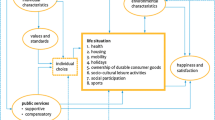Abstract
The absence of an explicit theoretical framework seems to have led to a number of objectionable features — empirical as well as conceptual — in previous attempts to construct and apply QOL measures. This paper presents a theoretical framework for QOL measurement based on individual utility maximization. Without severe restrictions on the form of the utility function, however, this framework does not lead to meaningful average or aggregate QOL measures. Furthermore, our empirical analysis indicates that attempts to use currently available QOL measures — despite their conceptual inadequacy — in the analysis of migration have been ill conceived.
Similar content being viewed by others
Bibliography
CebulaR. J. and R. K.Vedder: 1973, ‘A note on migration, economic opportunity, and the quality of life’, J. Regional Sci. 13, pp. 205–211.
Gillingham, R.: 1974, ‘A conceptual framework for the consumer price index’, Proceedings Business and Economics Statistics Section, American Statistical Association, pp. 246–252.
KatznerD. W.: 1970, Static Demand Theory (McMillen, New York).
LiuB.: 1973, Quality of Life in the U.S. Metropolitan Areas: 1970 (Midwest Research Institute, Kansas City).
LiuB.: 1974a, ‘Quality of life indicators: a preliminary investigation’, Social Indicators Research 1, pp. 187–208.
LiuB.: 1974b, ‘Variations in the quality of life in the United States by state, 1970’, Review of Social Economy 32, pp. 131–147.
LiuB.: 1975, ‘Differential net migration rates and the quality of life’, Rev. Econ. Stat. 57, pp. 329–337.
Pollak, R. A.: 1974, The treatment of the environment in the cost of living index (unpublished).
PollakR. A. and M. L.Wachter: 1975, ‘The relevance of the household production function and its implications for the allocation of time’, J. Polit. Econ. 83, pp. 255–277.
QuirkJ. and R.Saposnik: 1968, Introduction to General Equilibrium Theory and Welfare Economics, (McGraw Hill Book Company, New York).
U.S. Bureau of the Census, Statistical Abstract of the United States, Washington, D.C. (Various editions.)
WilsonJ. O.: 1970, Quality of Life in the United States: An Excursion into the New Frontier of Socio-Economic Indicators (Midwest Research Institute, Kansas City).
Author information
Authors and Affiliations
Rights and permissions
About this article
Cite this article
Gillingham, R., Reece, W.S. Analytical problems in the measurement of the quality of life. Soc Indic Res 7, 91–101 (1980). https://doi.org/10.1007/BF00305594
Received:
Issue Date:
DOI: https://doi.org/10.1007/BF00305594




